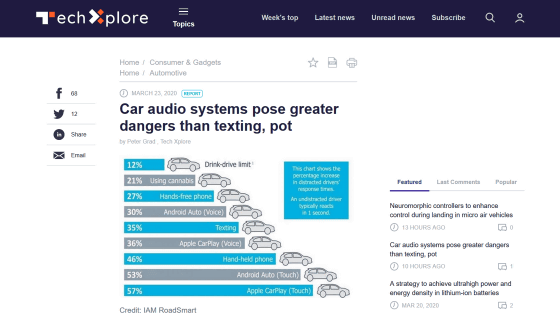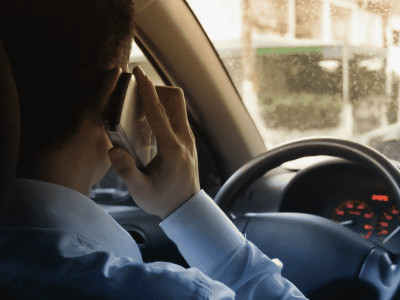Research results show that using an in-vehicle system that plays road information and music while driving 'reacts slower than drunk driving'

by
The in -vehicle infotainment system , which provides information such as road guidance and entertainment such as car audio while driving a car, can obtain necessary information without taking your hands off the steering wheel and enjoy distractions such as music. , Is generally thought to reduce the risk of traffic accidents. However, according to a study released by IAM RoadSmart , a British charity working to improve the safety of cars, 'using an in-vehicle infotainment system while driving is after drunk driving and marijuana intake. It may be more dangerous than driving. '
Interacting with Android Auto and Apple CarPlay when driving: The effect on driver performance
(PDF file) https://trl.co.uk/uploads/trl/documents/PPR948-_IAM-RoadSmart --- infotainment-sim-study.pdf
IAM RoadSmart Infotainment Research 2020
https://www.iamroadsmart.com/campaign-pages/end-customer-campaigns/infotainment
Hey Siri! Are the latest vehicle infotainment systems reducing road safety more than cannabis or alcohol?
https://www.iamroadsmart.com/media-and-policy/newsroom/news-details/2020/03/15/hey-siri!-are-the-latest-vehicle-infotainment-systems-reducing-road-safety -more-than-cannabis-or-alcohol
Car audio systems pose greater dangers than texting, pot
https://techxplore.com/news/2020-03-car-audio-pose-greater-dangers.html

Using in-vehicle infotainment systems such as
In a test conducted by the Transport Research Laboratory, three test runs were conducted using the same mock test course to evaluate the impact of using Android Auto and Apple CarPlay on driving. In the first run, the driver drives normally without using the in-vehicle infotainment system, in the second run, he drives using the in-vehicle infotainment system with voice control, and in the third run, he operates the touch panel. He said he drove while using the in-vehicle infotainment system.
The results show that using an in-vehicle infotainment system while driving distracts the driver, even when operating with voice control, and significantly reduces the time to respond to emergencies. This delay in reaction time was greater than drunk driving or driving with cannabis.
The graph below shows 'Test driving conducted by the Road Traffic Research Institute', 'Drunk driving', 'Driving with cannabis', 'Driving with hands-free calling', and 'Entering a text message on your smartphone'. It shows the change in the reaction time of the driver in 'driving while driving' and 'driving with a smartphone in hand while talking'. In-vehicle infotains such as Android Auto and Apple CarPlay have been shown to delay reaction time by 12% for drunk driving, 21% for cannabis use, and 27% for hands-free calling compared to normal drivers. You can see that there is an even longer reaction time delay when using the ment system.

In addition, it seems that the 'drunk driving' state in the graph refers to the state of 'blood alcohol concentration 0.08%' which is the standard value judged to be drunk driving in the United States and the like. The standard for drunk driving in Japan is 'breath alcohol concentration 0.15 mg / L or more', and when this value is converted to blood alcohol concentration, it becomes 'blood alcohol concentration 0.03%'.
When using the in-vehicle infotainment system with voice control, the reaction is delayed to the extent that it is comparable to driving while inputting a text message on a smartphone, and when using the in-vehicle infotainment system on the touch panel, it is nearly five times as much as during drunk driving. It seems that the reaction time is slowing down. The driver himself realized that he was distracted by the in-vehicle infotainment system and made corrections such as slowing down, but he could not keep a certain distance from the vehicle in front, and the reaction was delayed or the lane was delayed. It was said that it was off by up to 1.7 feet (about 50 cm).
IAM RoadSmart points out that the reaction time delay caused by using the in-vehicle infotainment system is equivalent to the average stop distance of 4 to 5 cars on the highway. In addition, it seems that the time it takes for the driver to take his eyes off the front while using the in-vehicle infotainment system is 12 to 16 seconds when operating the touch panel. We also found that drivers underestimated the amount of time they took their eyes off the road while using the in-vehicle infotainment system for about 5 seconds.
'It is estimated that driver distraction accounts for one-third of the causes of car accidents in Europe,' said Neil Craig, director of policy and research at IAM RoadSmart. 'This latest finding is up to date. It raises serious concerns about the development and use of in-vehicle infotainment systems. Anything that distracts the driver's eyes and attention from the road is bad for road safety. '

'Most of the drivers who participated in the survey reported that they were operating on the touch panel instead of voice control in actual driving. As the results reveal, touch panel operation is the driver's attention most. It is a distraction, 'he said, pointing out that voice control is safer when using an in-vehicle infotainment system. Also, if you really need to use an in-vehicle infotainment system, it is recommended that you complete all the setup before starting the drive and do not operate it while driving.
Related Posts:







